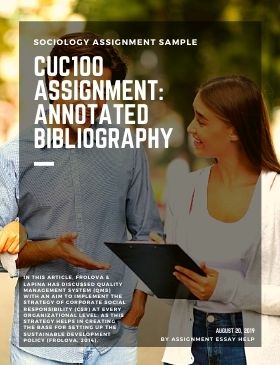
You can download the sample Sociology essay on CUC100 Assignment: Annotated Bibliography with the following question for free at the end of this page. For further assistance with Sociology Assignment help, please check our offerings in Sociology assignment solutions. Our subject-matter experts provide online assignment help to sociology students from across the world and deliver plagiarism free solution with a free Turnitin report with every solution.
(AssignmentEssayHelp does not recommend anyone to use this sample as their own work.)
Sociology Assignment Question
Assignment 2:
• The readings should appear in alphabetical order according to the author's surname. This means that they order they appear on Learnline is not necessarily the order they must appear in your assignment. Read Chapter 6 of your text (Rolls, N., & Wignell, P. (2015). Communicating at University: Skills for Success, Darwin: Australia, CDU Press) and do the activities.
• Think of your Final Essay (Assignment 4). Approach this assignment as the beginning of your research for your essay. It is meant to develop your critical reading and research skills, as well as help you begin your search for academic references on essential components of workplace citizenship;
• See below for an example of how to write your Annotated Bibliography (including organization and formatting).
Sociology Assignment Solution
In this article, Frolova & Lapina has discussed quality management system (QMS) with an aim to implement the strategy of corporate social responsibility (CSR) at every organizational level, as this strategy helps in creating the base for setting up the sustainable development policy (Frolova, 2014). They have considered QMS and CSR tools for achieving sustainability and organizational excellence (Frolova, 2014). Implementing CSR in the organizational policy supports in enhancing the employees well-being and enhance the process quality (Frolova, 2014). They have selected academic publications, and logical and comparative analysis for attaining the result through the survey as well as a statistical method of employee rotation (Frolova, 2014). In order to explain the CSR, various concepts are selected such as social performance, social responsibility, corporate citizenship, as well as sustainable responsible business (Frolova, 2014).
Frolova & Lapina has discussed the International Organization for Standardization (ISO) 26000:2010 guidelines that are implemented in most of the companies as its impacts on the decisions as well as activities on both environment and society by its ethical behavior (Frolova, 2014). They have stress over the CSR perspective, as the demands in the society is increasing, and therefore awareness about the CSR strategy is important to respond towards the expectations of the society that review the stakeholder’s interest (Frolova, 2014). They have even mentioned that through CSR activities in the company for a long period of time, the organizational cost is reduced, employee's loyalty is increased and overall process performance quality is improved (Frolova, 2014). Therefore, quality management system framework comprises of CSR activities, policies, strategies, and culture at all levels of the organizational management, and act as the base for setting up the policy of sustainable development and continuous improvement of the system (Frolova, 2014). Quality management system is the key to achieving organizational excellence, which can give valuable contribution in the well-being and development of the society (Frolova, 2014).
Judith, D. (2012). Communication in today’s workplace (Chapter 1). Frenchs Forest, N.S.W: Pearson Australia.
Dwyer, Judith in his book Communication in today's workplace discusses the lack of effective communication at the workplace that could lead to big disaster (Judith, 2012). In businesses, communication plays an imminent role and is considered as the base for attaining success (Judith, 2012). Dwyer, Judith mentions that proper type of communication is referred as the skill, which impacts the company (Judith, 2012). The business communication emergence is the tool that tries to facilitate the company to develop and improve its performance and skills by conducting better as well as effective communication (Judith, 2012).
Business communication is also referred as the intriguing tool for both the managerial faction and business personnel (Judith, 2012). It supports in attaining the goals oriented towards business and help in maintaining the profitability (Judith, 2012). Dwyer, Judith in this chapter has tried to explain about the protocol at the workplace that offers the medium for exchanging the important information among the personnel and set up a bond for achieving strong relationship among the stakeholders and partners (Judith, 2012). It's considered as the code of conduct, which improves the etiquette related to business and also improves behavior (Judith, 2012). Furthermore, the article analysis tried to depict the verbal communication which saves the time as well as tries to yield better performance and productivity (Judith, 2012). Formal communication usually leaves a high impact on the culture as well as ethics of the company (Judith, 2012). The verbal communication is considered as the medium by which organizational values are delivered to the client (Judith, 2012). Mostly written communication is applied for informing, persuading and for collaborating (Judith, 2012).
Yun, S., Cox, J., & Sims, H. P. (2007). Leadership and Teamwork: The Effects of Leadership and Job Satisfaction on Team Citizenship, International Journal of Leadership Studies, 2(3), 171-193, Retrieved from https://www.regent.edu/acad/global/publications/ijls/new/vol2iss3/yun/YunCoxSimsSalam_Vol2Iss3.pdf
In this article, Yun, Cox & Sims carries out this study with an aim to investigate about how to actually develop the Team Organizational Citizenship behavior (Yun, 2007). They try to examine if there is any different kind of relationship exist among the leadership and Team Organizational Citizenship behavior (Yun, 2007). Yun, Cox & Sims also conduct the theoretical study, which presents the literature review over leadership and citizenship behavior (Yun, 2007). They undertake citizenship due to the leadership result and mediate by the satisfaction through the job. In this article, Yun, Cox & Sims also explain about research methods in order to present the outcome and then move towards the discussion section (Yun, 2007).
As per the previous research that is conducted in the similar area, reveal about the characteristics of a leader such as, participation, consideration, as well as fairness and, are associated with the Organizational Citizenship behavior at the organization’s personal level (Yun, 2007). Yun, Cox & Sims has tested whether Team Organizational Citizenship behavior has any relation with the other types of the typology of leadership (Yun, 2007). They also try to investigate about the job contentment mediating responsibilities (Yun, 2007). Yun, Cox & Sims has concluded by mentioning that the character of the leader creates influence on Team Organizational Citizenship behavior both directly as well as indirectly through the satisfaction of job and different types of leader traits that are mainly developed for the purpose of manipulating the TACB and Team Organizational Citizenship behavior (Yun, 2007).


 WhatsApp Us
WhatsApp Us